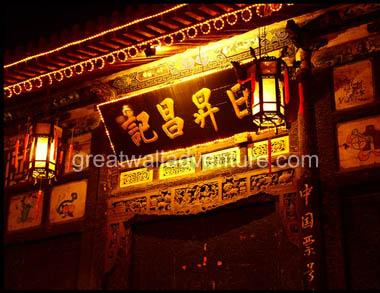|
|
Pingyao Tour of
Rishengchang
|
|
The Rishengchang Exchange Shop, one of the earliest
exchange shops in China, is located on West Street in Ping Yao City,
Shanxi Province. The rectangular compound faces north and is 65
meters (71 yards) long and 20 meters (22 yards) wide. In total it
occupies over 1,300 square meters (approximately a third of an
acre). It was established in 1823 during the Qing Dynasty
(1644--1911). At that time it had over 35 branches in China's major
cities. In December 1995, Shanxi Provincial Government listed it as
a Provincial Key Cultural Relic under the Reservation and it is now
the Chinese Exchange Shop Museum.
During the Qing Dynasty China's currency was silver
coin and there were obvious problems relating to security and
convenience if traders had to carry large sums of money in coin
form. The exchange shops offered a convenient alternative and thus
bills of exchange came into use and an early form of banking
created. Cash deposited at one branch could become payable by means
of a bill at another as a secure method of transferring funds from
one businessman to another regardless of time and distance. The
Rishengchang Exchange Shop acquired the reputation of Huitong
Tianxia, which means the silver coin and the bills of the exchange
could reach every part of the country. Before the establishment of
the modern banking system the Rishengchang Exchange Shop had a great
iA show of how the cashier works in the Qing Dynastynfluence on the
Chinese economy during the 108 years between its opening and
ultimate demise in bankruptcy. Due to its enormous influence upon
the development of banking in China, the Rishengchang Exchange Shop
has become a place of considerable interest to visitors in recent
years.
What you can see today is the original Rishengchang
Exchange Shop which was fully restored in 1995. The shop is within a
compound with three courtyards. In the front of the compound, five
rooms facing the street served as the gate of the shop. The board
with the name of the shop hangs in central position above the five
rooms. Passing through these rooms, you will come to the first
courtyard in which four cashier's offices are situated on either
side of the passage that runs along the axis of the compound. In the
second courtyard, the three south facing halls were used for the
exchange business. In the second courtyard there are also rooms
which housed the staff who worked in the exchange shop, while the
second storey served as store rooms. The third courtyard served as
accommodation for the senior staff and due to its location away from
the noise of the road also provided a resting place for important
customers. For security, a net made from metal thread was fixed over
the top of the whole compound. Small bells were hung on the net to
sound a warning if intruders tried to enter the premises.
Two dummy figures bending over their abacuses.A visit
to the Rishengchang Exchange Shop will give the visitor an insight
into the enterprise and ingenuity of the merchants of ancient China.
In particular it will illustrate how the Shanxi Merchants made a
vital contribution to the development of Chinese trade.
Tour Pingyao
with Great Wall Adventure Club, the best Pingyao
tour agent to help
you with your hotel booking and transfers.
|
|

